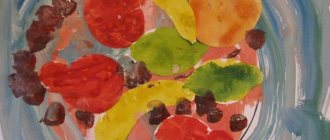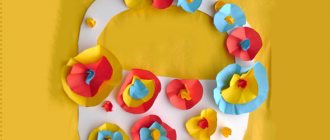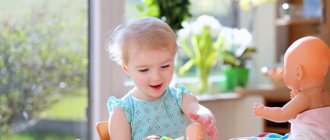1 Program content.
1. Clarify children’s knowledge about certain pieces of furniture and their purpose, teach them to correctly name different pieces of furniture and their parts, and understand the general word furniture.
2. Form the grammatical structure of speech: improve the ability to use simple prepositions.
3. Develop visual attention, visual memory, create prerequisites for the development of logical thinking.
4. Develop manual motor skills and precision of movements.
Material.
Flannelograph, toys for flannelgraph: bunny, fox, houses, stump, cubes, small toys for playing with the building, painting “Girl playing in a doll’s corner”, toy furniture, pictures: table, chair, armchair, wardrobe, doll, for applique: picture “Room”, stickers: cat, dog, cage with a bird, bear.
Progress of the lesson
I. Showing the beginning of the fairy tale “Zayushkina’s Hut” on a flannelgraph.
Teacher. Let's help the bunny and build a house for him. What should be in a house to make it comfortable to live there?
Children. We need a chair, a table, a bed—furniture.
Teacher. Let's build the bunny furniture from cubes.
II. Building furniture from cubes and playing with buildings.
Teacher. What kind of furniture did we build for the bunny? (Children name pieces of furniture, put a bunny on a chair, put toy dishes on the table, etc.)
III. Physical exercise to the music “Bunny”.
Teacher. The bunny says “thank you” and wants to dance with you. (Children move freely to the music.)
IV. Looking at the painting.
Teacher (shows the picture, asks questions, helps with answers if necessary). Look at the picture, the girl also has doll furniture. What is the girl doing? Where did she put the doll? Where will she feed the doll? Where will the doll be placed? Where will he put the doll plate? What is this? Why do you need a closet? What's in this closet? What is the name of the cupboard? The doll can sit on a chair, or maybe on...
Children. Armchair, sofa.
Teacher. Let's see what the chair has?
Children. Legs, seat, back.
Teacher. What's on the table?
Children. Legs, table top.
Teacher. You and I made furniture from cubes, but you can make a table and chair from our palms..
V. Finger play.
Teacher.
Legs, back and seat -
Here's a chair for you, surprisingly.
The table has four legs
The lid is like a palm on top.
(Children place four fingers (except the thumb) on the table, like the legs of a chair, palm parallel to the surface of the table)
VI. Game "Fourth wheel".
Teacher. Look at the pictures, what's missing here? A table, chair, sofa are furniture, and a doll is a toy.
VII. Didactic game “What’s missing?”
Teacher. This sheet of paper will be the room (places toy furniture on the sheet). What furniture did I put in the room? Close your eyes, now open them and tell me what’s missing.
VIII. Didactic game “Where the bear hid.” (Children, according to the teacher’s instructions, must find a plush
A lump under a chair, on a table, behind a sofa.)
IX. Application "Let's plant the animals."
Teacher. Look, the picture shows a room. What furniture is in this room? Let's put the cat on the chair and the dog under the table. The cage with the bird will be on the table, and next to the chair we will place the bear. (Children stick pictures.)
Abstract of educational activities for cognition in the 2nd junior group “Furniture”
Goal: to consolidate children’s knowledge about furniture.
Objectives: to form children’s ideas about what kind of furniture there is; consolidate the names and knowledge of the purpose of furniture; activate the general word “furniture” in speech; arouse interest in the furniture in the group; expand children's vocabulary; train visual memory; develop speech, attention, thinking, creative abilities; develop the ability to solve riddles.
Materials and equipment: teddy bear toy, Furniture cards, magnetic board, coloring books with pictures of furniture, telephone.
GCD Educator. -Children, come to me! I'm so glad to see you! Let's hold hands and smile towards each other. Tell me, do you like fairy tales? Do you want to go on a trip to some fairy tale? Heavy snow has fallen, and we will go skiing into a fabulous winter forest. Get on your skis! Let's go! (Children imitate skiing)
- Oh, I think someone is crying. Look, little bear! It seems that we found ourselves in a fairy tale earlier than expected. Let's ask what he's doing here and why he's crying. Baby, what are you doing here? Why are you so upset?
Little bear. -My name is Mishutka. I am from the fairy tale “The Three Bears”. Mashenka broke my high chair and my crib, and now I don’t know what I’ll sit on and sleep on. It will be uncomfortable for me to sit and sleep on the floor!
Educator. -Mishutka, do your mom and dad know where you are? (No). You are still small, and children should not leave home alone. Let's do this. Do you remember the way home? (No). Then let’s go visit us, and I’ll now call my friend the forester, so that he tells your parents that you are visiting us, and they can pick you up. (He calls, then invites the children to return to the group)
Educator. -Mishutka, you are probably tired and cold. Please sit down at the table and have some tea!
The little bear is “drinking tea.”
Little bear. -Thank you, I have completely calmed down. What a wonderful table you have! What is the name of the backless chair I was sitting on? (Stool) How beautiful it is! How much you have... everything...! Not at all like at home.
Educator. -Children, let’s remember what furniture was in Mishutka’s house. What were the bears sitting on? Where were the dishes? What did the bears sleep on? (Children's answers)
Little bear. -And I would really like to know what everything else is for? What are these soft, soft chairs called? (Chairs) What are chairs for? (Sits in a chair) How comfortable it is to sit in them! What kind of table is this with a mirror? (Tumeau) What is it with the shelves? (Cabinets) What are they for? Lockers in the locker room? (Look at furniture in a group). Do you have a bedroom? What's in it?
Educator. -Children, what do we have in our bedroom? (Beds, sofa, coffee table, wardrobe)
Little bear. - Oh, so many things! I probably won't remember everything. Can you call it all in one word? Which one? (Furniture) How many new things I learned! Let's play now! Also an interesting activity on cognitive development for 2 ml. groups: Notes of GCD in the second junior group. Cognition. “Cat and Mice” Physics lesson “Teddy Bear” Teddy bear walks through the forest, collects cones and puts them in his pocket. Suddenly a cone fell right on Mishka’s forehead. Mishka got angry and stomped with his foot! (The text is accompanied by appropriate movements)
Educator. -We played with you, Mishutka. Now come play with us. I invite the children to guess the riddles, and show you the answers. (Cards with pictures of furniture are placed on the board) If Vova wants to sleep, he will lie down on (bed). We want to read if we like to lounge in (an armchair). To rest our legs, let’s sit a little on (a chair). Katya took out the giraffe, the ball and the gnome from the (closet).
Educator. -Now let’s play the game “What’s missing?” On the board you see cards with pictures of furniture. Look carefully and remember what is here. Now close your eyes tightly. I remove one card. Look what's missing. The game "What's missing?" Educator. -Let's remember once again what each of these items is called and how to call them in one word? Did you enjoy playing with Mishutka? (Phone call) -Hello! Hello! Yes, we have your Mishutka and you can pick him up. Yes, of course I will! Children, mom and dad came for Mishutka, they bought him a new high chair and crib, but they can’t come here, they’re adult bears. Let's say goodbye to him, and I'll take him to his parents, and you wait for me here.
Little bear. -I was so pleased to meet you! I learned a lot today. Thank you for everything! I will never leave home alone again. Goodbye! (The teacher takes out Mishutka and returns)
Educator. -Children, Mishutka’s mom and dad are very glad that you looked after Mishutka. They gave you this envelope as a gift. Want to know what's in it? (Opens the envelope and takes out coloring books). Let's see what's on these coloring pages. (Furniture). Now in your free time you can paint the furniture to your liking.
Title: Notes of GCD on cognition in the 2nd junior group “Furniture” Nomination: Kindergarten, Lesson notes, GCD, development of ideas about the world around us and about oneself, 2nd junior group Author: Katunina Lyubov Sergeevna Position: teacher Place of work: MCOU “Ivaninskaya Secondary School” » Location: Kurchatovsky district, Kursk region
Date modified: 02/01/2016 Date of publication: 02/01/2016




